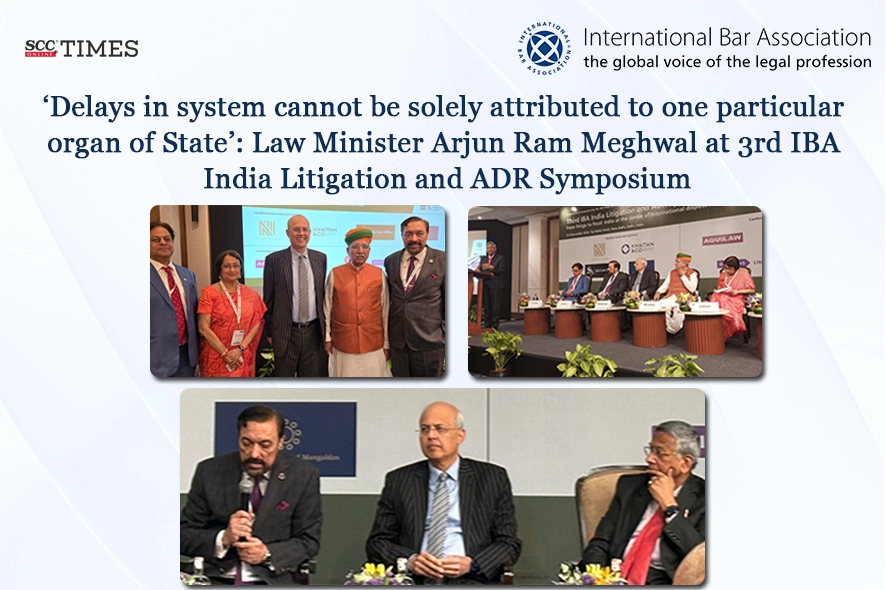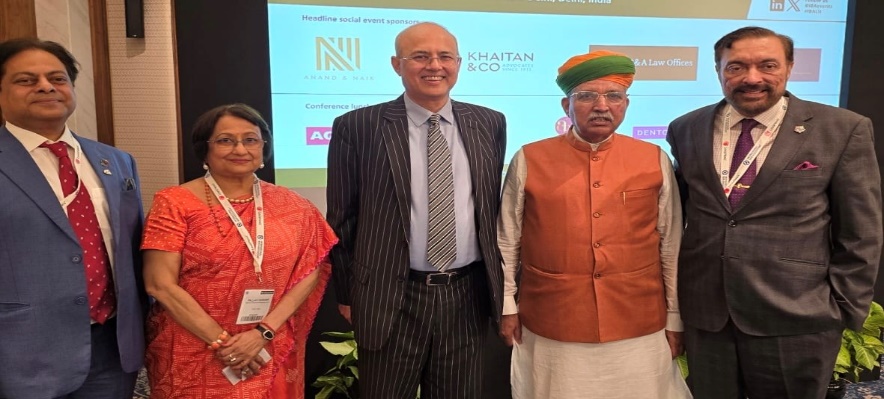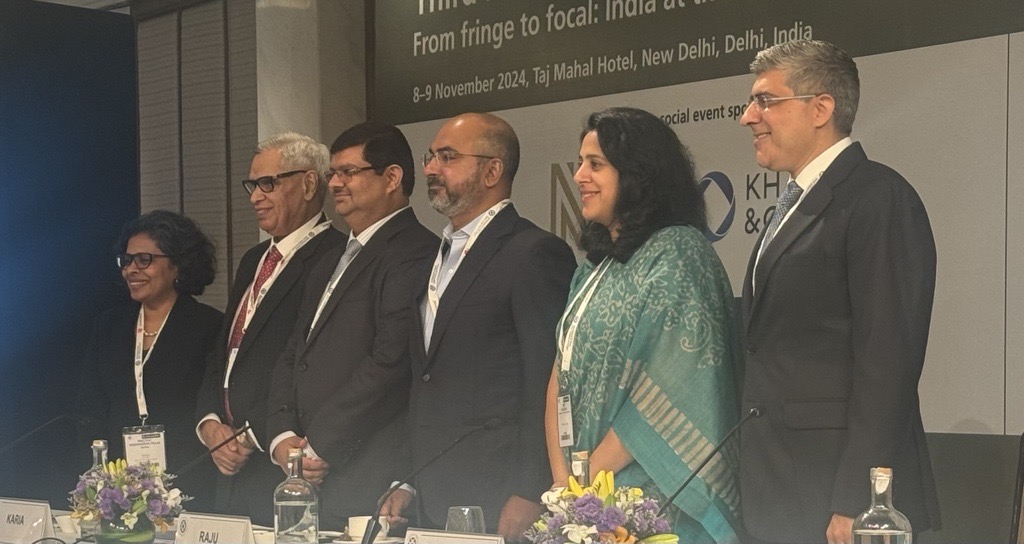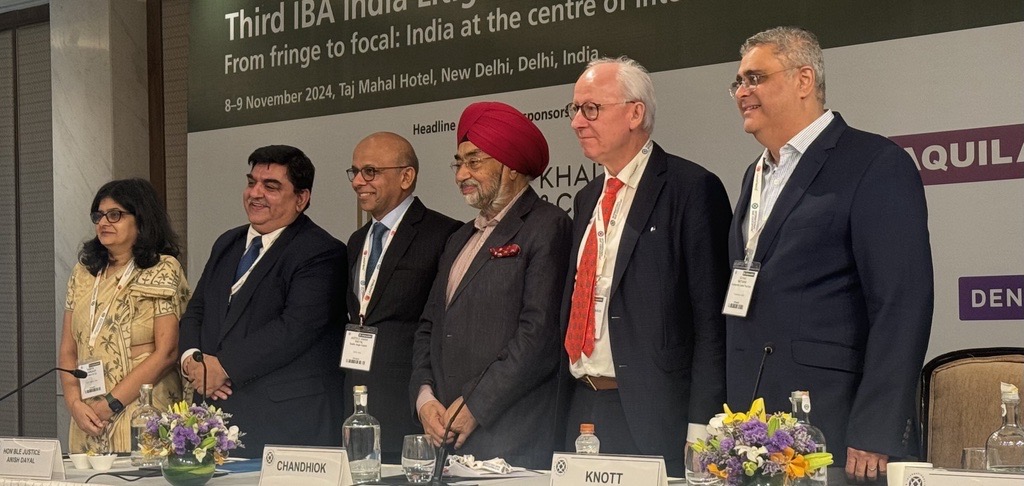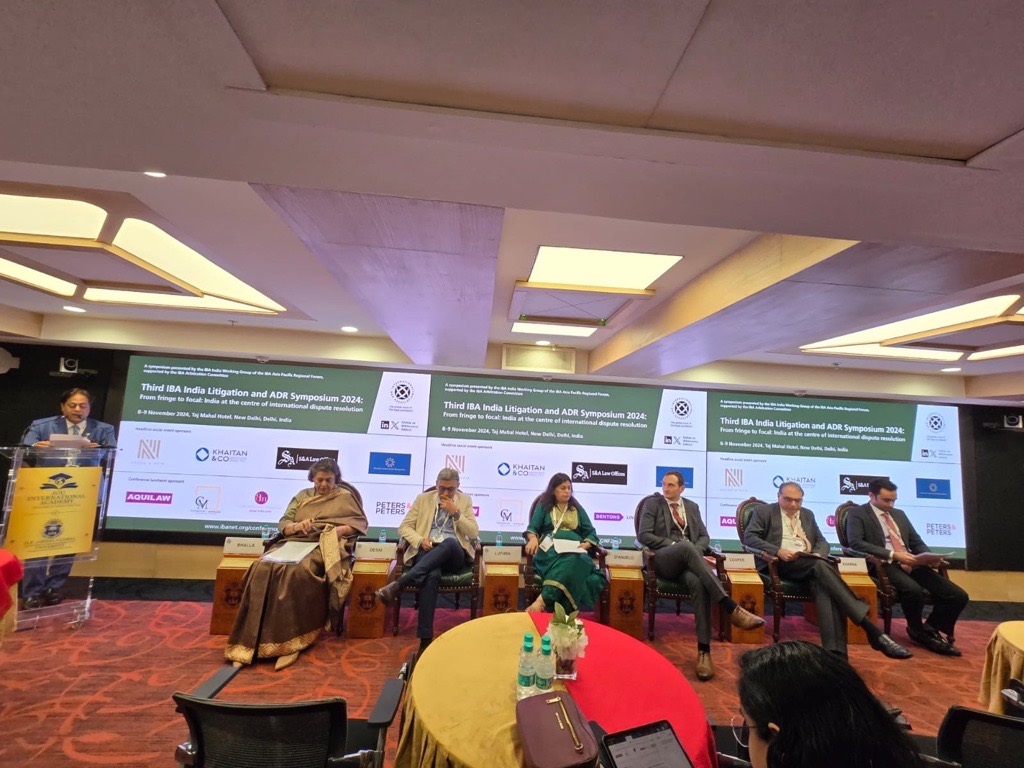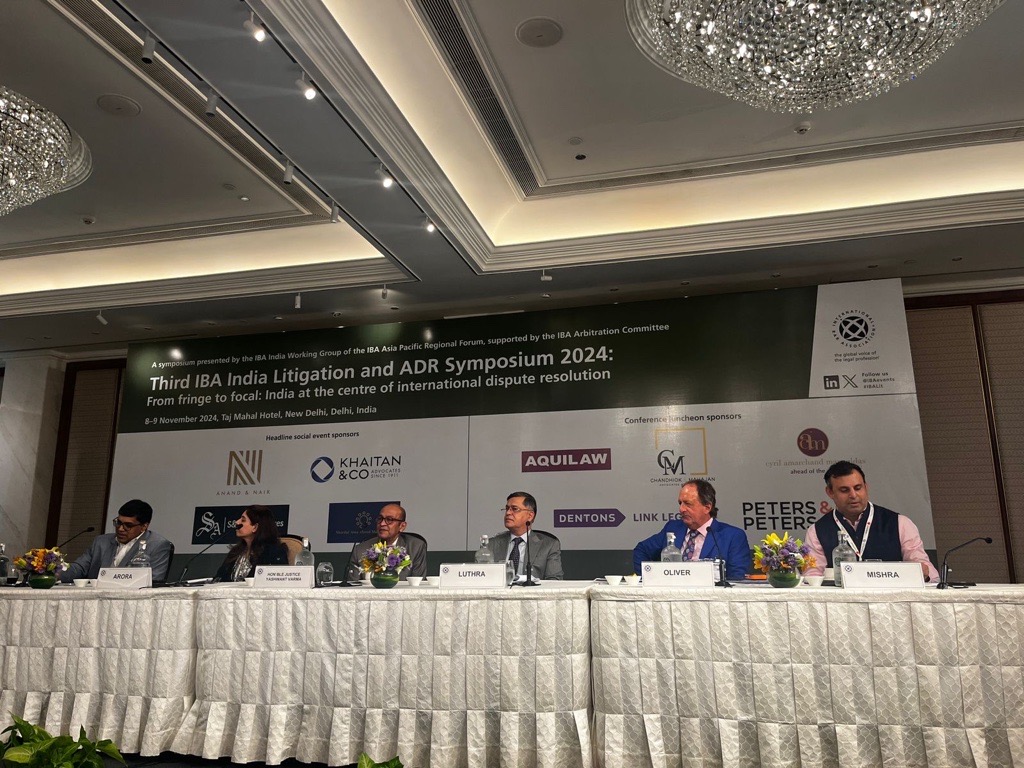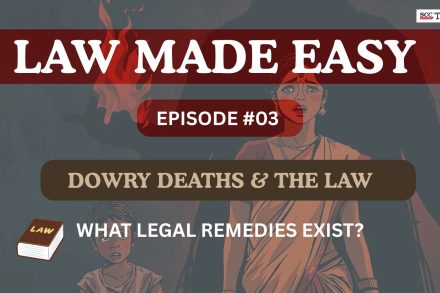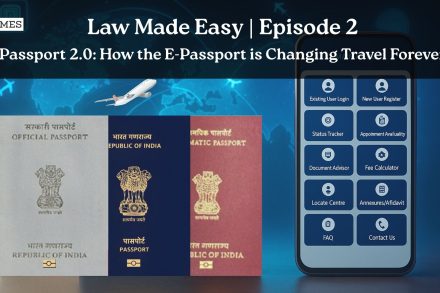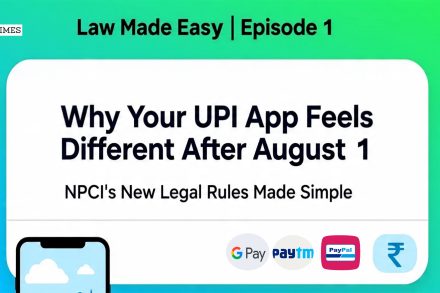The Third IBA India Litigation and ADR Symposium 2024 was held on 8th and 9th November 2024, presented by the IBA India Working Group of the IBA Asia Pacific Regional Forum. The event focused on India’s evolving role in international dispute resolution, highlighting the country’s shift from being a peripheral player to a central hub in global litigation and alternative dispute resolution (ADR). Legal experts, practitioners, and policymakers came together to discuss the emerging trends and strategies shaping the future of dispute resolution in India and across the Asia-Pacific region. The symposium provided a platform for in-depth discussions and insights on the key issues affecting the legal landscape.
Some of the prominent discussions included the effectiveness of the Indian justice system, exploring India’s institutional arbitration odyssey with a focus on party autonomy vs institutional control in arbitration. The symposium also delved into the art of cross-examination, its ongoing relevance in modern dispute resolution, and the critical role of written advocacy in international disputes, particularly in drafting pleadings and witness statements. Other significant topics included white-collar crime, bribery, and corruption, with a comparative analysis of global approaches, as well as emerging trends in intellectual property disputes in Asia. The event ended with a great debate on arbitration as the most appropriate mode of commercial dispute resolution with litigation becoming less relevant.
Mr. Amir Singh Pasrich, an expert from International Law Affiliates and LPD Assistant Treasurer / IBA Assistant Treasurer, started the conference by discussing the ‘Effectiveness of the Indian Judicial System’. He raised several thought-provoking questions:
-
What do we mean by the effectiveness of the legal system?
-
Is the Indian Justice System too slow?
-
Does it demonstrate remarkable speed when there’s urgency?
-
Could the growing backlog of cases lead to a paralysis of the system?
-
Is the Rule of Law in India merely an illusion that will be hard to maintain in the 21st century?
-
And how will India address the arrears that have accumulated, especially during the Covid-19 period, often referred to as the ‘pendency pandemic’?
He pointed out that while solutions like increasing the number of judges might help, the real answer likely lies elsewhere.
He stressed the importance of questioning whether the current judicial system is truly suitable for our needs.
He further cited a quote from Justice Krishna Iyer in Sushil Kumar Sen v. State of Bihar, (1975) 1 SCC 774:
“The processual law so dominates in certain systems as to overpower substantive righis and substantial justice. The humanist rule that procedure should be the handmaid, not the mistress, of legal justice compels consideration of vesting a residuary power in Judges to act ex debito justiciae where the tragic sequel otherwise would be wholly inequitable.”
He cited Mathews J. Nedumpara v. Union of India, (2024) 1 SCC 1, decided by a 3-Judge Bench of the Supreme Court, wherein the Court made striking observations about the petitioner’s conduct. The Court described the pleadings of the petitioner as “almost reckless in character” and even “contemptuous in character,” noting that the petitioner’s approach appeared to be part of a “vilification campaign against all and sundry.” Despite these severe remarks, the Bench chose to dismiss the petition with no order as to costs, stating that the system had not been able to correct the petitioner in his approach. Mr. Pasrich remarked that he cited this case, as he thinks that this is the trend in India.
He also discussed the potential for using Artificial Intelligence in judicial decision-making, noting that technology could play a significant role in addressing the growing backlog of cases in the Indian judicial system. He expressed optimism that, in the next 5-7 years, digitization could help reduce pendency and streamline the judicial process. While he acknowledged the current challenges, he emphasized that the system itself is not flawed, but that collective efforts toward reform are necessary.
Following the insightful speech by Mr. Pasrich, the event proceeded with keynote address from prominent speakers who provided valuable perspectives on the effectiveness of the Indian judicial system.
Justice Manmohan, Chief Justice, Delhi High Court emphasized the importance of dialogue and open discussion in the judicial process, acknowledging that different perspectives and approaches exist. He pointed out that when stakeholders in the system—whether judges, lawyers, or policymakers—engage in meaningful conversations, solutions can be found to complex challenges.
He also remarked on the strength and integrity of the Indian judicial system, emphasizing its independence and autonomy.
He further underscored the significance of India’s open courts, emphasizing that one of the most remarkable aspects of the judicial system is its transparency. He expressed that the openness of the courts is a feature that deserves greater appreciation. In an open court system, hearings are accessible to the public, allowing citizens to observe the judicial process firsthand. This transparency not only ensures accountability but also reinforces the public’s trust in the judiciary.
Chief Justice Manmohan pointed out that any matter of public importance is brought before the court, reinforcing the significant role the judiciary plays in safeguarding the public interest. He noted that this visibility and engagement with pressing societal issues contribute to the high level of public confidence in the institution. However, he also acknowledged the strain on the system, highlighting the challenge of managing a caseload with only 36 judges for a population of 3.3 crore in Delhi.
He suggested that one of the key areas the judicial system needs to focus on is improving ‘certainty’ and ‘predictability’ in legal outcomes. Additionally, he pointed out the need for adequate infrastructure to meet the demands of a growing and evolving judicial system.
While acknowledging the legislative changes that have been introduced, the Chief Justice highlighted that there are still fundamental issues that require attention.
After the insightful speech by Justice Manmohan, the discussions continued with further speeches from other prominent figures in the legal fraternity.
Mr. R. Venkataramani, the Attorney-General for India, spoke candidly about the challenges facing the Indian judicial system, emphasizing the complexities that arise as democracy expands. He pointed out that as the legislative framework grows, it inevitably leads to more human transactions, increasing the need for judicial intervention. However, he cautioned that simply adding more courts to handle the growing caseload may not be the right solution; there is something more fundamental that needs addressing. Mr. Venkataramani argued that law is increasingly occupying every aspect of our lives, which necessitates not just more courts, but also more ‘dispute resolution mechanisms’.
He stressed that a “one-size-fits-all” approach to justice is no longer sufficient, as different sections of the country have diverse needs when it comes to accessing justice. In particular, he noted that India still has a long way to go in the criminal justice system, implying that significant reforms are needed before it can be deemed fully effective.
Mr. Venkataramani also advocated for the greater use of ADR mechanisms, such as arbitration and mediation, to ease the burden on the courts. He suggested that India should take bold steps to institutionalize ADR, as it has the potential to alleviate the “litigation syndrome” that overwhelms the traditional legal system. According to him, if ADR becomes more widely adopted, the reliance on conventional litigation could decrease significantly.
Finally, Mr. Venkataramani emphasized the need for dedicated institutions focused on legal and court system reforms, calling for a structured approach to overhaul the judicial system, improve efficiency, and reduce delays. He argued that such institutions could drive necessary changes, fostering a more responsive and accessible justice system for all.
After Mr. Venkataramani delivered his speech, Ms. Pallavi Shroff, Managing Partner at Shardul Amarchand Mangaldas & Co., and Co- chair, India working group took the floor to share her insights.
In her address, she highlighted the evolving nature of the Indian legal landscape, particularly in the context of arbitration and dispute resolution. She acknowledged that while laws have been amended over time, and the judiciary’s approach to arbitration has evolved significantly, there is still room for improvement. Ms. Shroff emphasized that the creation of more institutions dedicated to dispute resolution, like the Mumbai Centre for International Arbitration (MCIA), would further strengthen the system. She remarked that improving access to arbitration and ADR mechanisms is a long process, but one that is essential for better managing the growing complexity of legal disputes in India.
Ms. Shroff suggested that there should be studies conducted to understand whether people prefer to resolve their disputes through ‘courts’ or ‘arbitration’, as this could inform how dispute resolution systems should be shaped moving forward. She stressed that efficient dispute resolution systems are critical for the country’s legal infrastructure.
Regarding delays in the judicial process, she mentioned that we have a multi-pronged approach to address them. Ms. Shroff advocated for the integration of technology, artificial intelligence, and case management systems to streamline court procedures and improve efficiency.
Finally, Ms. Shroff pointed out that India is learning from global experiences in dispute resolution, such as those from the International Bar Association (IBA), and integrating these lessons to strengthen the Indian legal system.
After Ms. Pallavi Shroff’s address, Shri Arjun Ram Meghwal, Minister of State for the Ministry of Law and Justice, took the stage. In his speech, he addressed the challenges within the Indian legal system by referring to the three core organs of governance—the executive, the legislature, and the judiciary—as outlined in the Constitution.
Mr. Meghwal highlighted that both the Arbitration Act and the Mediation Act have been amended to meet evolving needs, signaling the government’s commitment to improving ADR mechanisms.
However, he emphasized that delays in the system cannot be solely attributed to one particular organ of the state, whether it be the judiciary, the executive, or the legislature. He argued that a more comprehensive and balanced assessment of the strengths and weaknesses of each part of the system is required to foster meaningful change.
He suggested that ‘introspection’ remains the key solution to addressing the deep-rooted issues like delays, inefficiencies, and access to justice.
Mr. Nusrat Hassan, Managing Partner at Dentons Link Legal and Co-Chair of the India Working Group, concluded the conference by extending his appreciation to the sponsors of the event. He also took the opportunity to speak about the ‘India Working Group’, highlighting its role in fostering dialogue, collaboration, and exchange of ideas on key legal and policy issues in India.
The second day of the Symposium on 9th November, 2024 opened with a plenary session on- India’s institutional arbitration odyssey: a vision for the future of dispute resolution (party autonomy vs institutional control). The session explored India’s new arbitration institutions, like the India International Arbitration Centre (IIAC), Mumbai Centre for International Arbitration (MCIA), the International Arbitration and Mediation Centre (IAMC), Hyderabad and their efficacy. The session further explored the benefits of institutional arbitration as against ad hoc arbitration.
The panel moderated by Ms. Preetha Pillai, Skrine, Kuala Lumpur; Co-Chair, IBA Asia Pacific Regional Forum; Mr. Atul Sharma, Dentons Link Legal featured Mr. Tejas Karia, Shardul Amarchand Mangaldas & Co.; Mr. Naveen Raju, General Counsel, Mahindra & Mahindra; Ms. Neeti Sachdeva, Registrar and Secretary General, MCIA; and Mr. Amit Sibal, Senior Advocate.
After introducing all the panellists, Ms. Preetha opened the floor for Ms. Neeti to discuss the shift from ad hoc to institutional arbitration. To shed light on the number of parties moving towards institutional arbitration, Ms. Neeti pointed out that unfortunately there is no precise statistical data to suggest how many parties are going into ad hoc arbitration or institutional arbitration, however, to substantiate that there is a shift towards institutional arbitration she referred to a survey conducted by Khaitan & Co. on ‘Current trends in domestic arbitration in India’ which suggests that 52% of the respondents expressed their preference for institutional arbitration; 40% for ad hoc arbitration and 8% were neutral.
In terms of domestic arbitration, she remarked that ad hoc arbitration is not completely out of the picture, but institutional arbitration has picked up the pace and asserted that it has made good progress.
Advancing the conversation, Mr. Atul asked Mr. Karia to share his insights on the same. Mr. Karia pointed out that because of the perception of flexibility and control the Indian parties exercised over the arbitration process ad hoc arbitration was the most preferred traditionally. Taking a clear stand, he expressed that irrespective of the jurisdiction, institutional arbitration (IA) has clear advantages over ad hoc arbitration. Putting across some of the advantages of IA including the end-to-end support from the appointment of an arbitrator to awards, he viewed that IA has clear advantages than ad hoc. He discussed that a clear framework; time-tested tools; and a defined process make IA preferable and suggested that there is a need to promote IA and leave it for the institutions to decide on the appointment of arbitrators, as there are advantages of the same considering the requirement of technical expertise; and involvement of large amounts in disputes. He also highlighted that the systems that are used by institutions for the appointment of arbitrators take away the burden of the courts, unlike ad hoc arbitration where courts are relied upon.
“The ultimate goal is to reduce time and cost and build trust.”
-Mr. Tejas Karia
Further, he banked upon the administrative support provided by the institutions namely the cost-calculator, payment of fees, fee schedule, etc. Additionally, he highlighted that the institutions can scrutinize the awards, making them less prone to get challenged before the courts. Mr. Karia also pointed out the aspect of diversity and said that arbitral institutions are conscious of ensuring diversity in the appointment of arbitrators. He said that without technology there is no survival and posited that institutions are advanced and have adopted technology. Further, he stated that the answer to delays and huge costs lies in IA. Hence, he stated that IA is the future.
To get a contrary view, Mr. Atul steered the conversation towards Mr. Sibal. Defending the cause of ad hoc arbitration, he suggested that considering the unique situation of arbitration in India, the two should not be seen in confrontation, but be seen as part of an integrated eco-system where they can help each other. He posited that most of the arbitration clauses in India are ad hoc and no magic wand can overnight turn them into IA clauses. Hence, he stated that “ad hoc arbitration has a substantial role in the Indian eco-system.” Mr. Sibal remarked that it is necessary to remind ourselves and people as to why ad hoc arbitration was chosen in India and to corroborate the same, he stressed on the features of ad hoc arbitration making it a choice for India. Highlighting the advantages of ad hoc arbitration, he stressed on party autonomy, which is fundamental for arbitration and that the same is an important feature rooted in ad hoc arbitration. Further, he added that the freedom to hire domain expertise and lower cost are some of the traditional reasons making ad hoc a choice. To take this medium route and resolve the issues, he suggested that focus should be on the ‘weaknesses’ and on ‘how to deal with them’. Shedding light on some of the pitfalls of ad hoc arbitration, namely, delay in appointments and due process paranoia he expressed that the solutions to zero down these weaknesses lie in the proposed legislative reforms to the Arbitration Act.
“Institutional arbitration and ad hoc arbitration can co-exist.”
-Mr. Amit Sibal
Mr. Sibal averred that the proposed Amendment Arbitration and Conciliation (Amendment) Act, 2019 suggested for the arbitral institutions to take on the appointment process lowering the burden of the courts. He remarked that such solutions bring into the loop, the ‘co-existence point’.
Coming back to Ms. Neeti, Ms. Preetha asked her about the arbitral institutions in India and the move towards foreign arbitral institutions. Drawing a landscape of domestic arbitral institutions, Ms. Neeti talked about the shift from ad hoc arbitration and also discussed the pivot to foreign arbitral institutions. She opined that there was a lack of credible arbitral instructions, who could deliver what the sophisticated parties were expecting them to deliver. She stated that this lack on part of domestic arbitral institutions led the international institutions to enter into the Indian market. She divided arbitral institutions in India into three categories- a. under the aegis of the courts; b. centres run under the Chambers of Commerce; c. institutions such as IIAC, MCIA, and IAMC. She highlighted that recently big conglomerates have chosen Indian arbitral institutions which testaments that there has been a shift back to domestic institutions to some extent. However, she emphasized that it is not the institution alone, but the Rules; administration; and eco-system around the arbitral institutions, which should be favourable. Further, she stressed that in India two important factors that play a role in the arbitration eco-system are- cost and courts.
For a take on capacity building, Mr. Atul asked Mr. Sibal to share his views. Mr. Sibal focused on three areas which can be looked upon to address capacity building- 1. the problem of peripatetic lawyers; 2. restricting the pool of arbitrators to retired judges; and 3. the dedicated arbitration bar. Delving on the question of how the proposed legislative amendments address these issues, Mr. Sibal focused on the Arbitration Council of India which can regulate, recognize arbitral institutions, provide fee schedule for arbitral tribunals, frame a model code of procedure for arbitral tribunals, draft model arbitration agreements, maintain a repository of awards. He stated that these limbs would address several issues that the panelists have raised in this discussion.
Session: ‘The importance of written advocacy in dispute resolution: mastering the art of drafting pleadings and witness statements’
This session dealt with important questions of practice, such as- what happens to a dispute after arguments are concluded? Do judges read everything? Do words matter? Do judges render judgments quickly or only after carefully examining the entire record and hundreds of pages to make up their own minds? Or should they depend only on what they have heard in court from counsel? How important are written pleadings and drafting?
The Keynote speech for the session was delivered by Justice Anish Dayal, Judge, Delhi High Court. Moderated by Ms. Vanita Bhargava, Khaitan & Co., and Anubhav Kapoor, General Counsel, Samvardhana Motherson Group, the panel featured Mr. Amarjit Chandhiok, Senior Advocate; Dr. Hermann Knott, Kunz Law, Cologne; CDRC Liaison Officer, IBA Mediation Committee and Mr. Suhail Nathani, Economic Laws Practice.
In his keynote address, Justice Dayal explored the above-mentioned questions and explained that written advocacy encompasses a lot more than just drafting of a pleading. He stated that it involves all that is presented to a Bench or Tribunal by an advocate in support of the case, including pleadings, written submissions, written notes of arguments, synopses, list of dates, grounds, case note, witness statements etc.
“Prolixity, verbosity, over-articulation, and repetition are old friends of lawyers.”
-Justice Anish Dayal
Dealing with- what does a Bench expect from counsel, Justice Dayal remarked that, “better written advocacy leads to better adjudication and greater efficiency on the dais, therefore leading to better disposal, which is the crying need of the hour.”
He viewed that brevity in drafting, use of plain English, avoidance of Latin, short sentences, appropriate paragraphing, the sequential and chronological flow of the narrative, and precision in grounds and prayers are expected by the Bench. Justice Dayal suggested that synopsis or written submissions ought to be logically consistent, succinct, and not over-fraught with contentions and citations. However, striking the reality, he furthered that a petition, pleading, or written submission is not presented to the Bench/ Judges but “dumped” on them.
Elaborating this, Justice Dayal quoted a postscript from Facebook v. Delhi Legislative Assembly, (2022) 3 SCC 529:
“The saga of the hearing lasted 26 hours — which is a lot of judicial time. Daily time period was recorded. Apart from pleadings, there were written synopses, additional written synopses, rejoinders and replies filed liberally by both parties. The convenience compilations themselves were very voluminous, in contradiction to their very purpose. Our concern is if this is how the proceedings will go on in the future, it will be very difficult to deal with the post COVID period, which is likely to see a surge in the number of cases pending adjudication”.
He reiterated the Supreme Court’s suggestion that counsels must be clear on the contours of the submissions from the very inception of arguments, submitted as a brief synopsis and strictly adhered to. He suggested that the Wren & Martin principles of precis writing must be adopted.
Coming onto the judicial precedents and long list of citations, Justice Dayal stated that law, as it stands on a particular point, can easily be exemplified by one or two most recent decisions and that there is no need to add ten or fifteen of them. He pointed out that this not only distracts a judge from the proposition in issue but also adds to the bulk of the judgement.
Setting the tone for the panel, Justice Dayal also mentioned that presenting the written submissions in advance to a Judge helps in circumscribing the length of the hearing, and significantly assists in judgement writing.
Taking over from Justice Dayal, the Ms. Vanita Bhargava, introduced the panellists and handed over the reins to Mr. Kapoor who asked Mr. Chandhiok to give his thoughts about the modern-day style of drafting and what basics must be kept in mind while drafting pleadings.
Mr. Chandhiok highlighted the fundamentals of drafting, which are understanding the subject matter of the case, application of mind, writing the appropriate prayer, ensuring that the court has jurisdiction, being precise and to the point, not being repetitive, and having a clarity regarding the facts and documents.
Thanking Mr. Chandhiok, Ms. Vanita posed a few questions to Justice Dayal on what measures can be taken to ensure that pleadings are drafted concisely, especially on the end of judiciary and whether AI can be used by new generation of lawyers in drafting?
Justice Dayal answered that the judges can rebuke the lawyers for their drafting as they will not be met with much argument, as many times judges come across elaborate drafting. Coming to the question of AI, Justice Dayal said that there is a growing concern regarding pleadings being made with the use of AI and judges will have no way to check that. He underscored the dangers of the use of AI for drafting.
Taking over from Justice Dayal, Mr. Anubhav asked Mr. Suhail to share thoughts on how lawyers can balance client satisfaction, which often comes from lengthy drafts, and remaining concise. He also asked Mr. Suhail to talk about effects of inadequate drafting.
Mr. Suhail talked about how the legal system of the US works very differently, in fact they have a limit on how many words they can use in certain drafts, but the Indian legal system is sadly far from such measures. He stated that it is in fact, harder to write concisely while mentioning everything important. On the question of client satisfaction, he stated that lawyers must explain to their clients that it is in their best interest that the pleadings are concise and accurate instead of lengthy and elaborate, this also showcases the amount of trust that a lawyer can inspire in a client.
Coming to the second question of balancing adequacy and brevity, Mr. Suhail answered that the profession is changing, clients are much more knowledgeable about law and their case, so a lawyer has to be specialist and sharp.
Moving on to the last speaker of the panel, Ms. Vanita opened the floor for Dr. Knott to talk about his experience as a lawyer in the US and how can one simplify legal proceedings.
Dr. Knott talked about his experience in arbitration where everything has to be presented beforehand, the documents, evidence, arguments, which aids the process, but the production of these documents has become lengthy. He highlighted that there is very little education on how to use language despite it being the most important tool for a lawyer. He also underscored the importance of efficient client communication as it helps in understanding the client and the intricacies of the case.
M. Vanita posed a question of what can be done because written statements are being used to respond to averments which are not being pleaded in the pleadings, to Mr. Suhail.
Mr. Suhail stated that typically the pleadings are written by someone different than the one who is arguing the matter so there is a chain of people making the pleading. This leads to two problems, one the quality of drafting and second is the loss of judicial discipline. He also highlighting that the legal system is so disconnected from the people due to the delays which are caused by such lengthy processes and pleadings.
Ending the session Ms. Vanita concluded that it can be understood that less can be more when it comes to written advocacy.
Session: Aspects of the art of cross-examination and its relevance in modern dispute resolution
The panel, moderated by Ms. Ritu Bhalla, Partner, Luthra & Luthra, and Mr. Arush Khanna, Partner, Numen Law Offices, featured Mr. Soli Cooper, Senior Advocate, Mr. Massimo D’Angelo, Partner, Blank Rome LLP, Ms. Geeta Luthra, Senior Advocate, and Mr. Vyapak Desai, Nishith Desai Associates.
Starting with the opening address, Ms. Ritu talked about how it is debatable whether cross-examination is a science or an art, but it is a very important aspect of a trial that every litigator dreams of acing. She then introduced the panel and handed over the reins to Mr. Arush.
Mr. Arush started the panel discussion by inviting Mr. Soli to give his thoughts as he had drafted a paper presentation on the art of cross-examination and how it is a critical component, not only in an adversarial proceeding, but also critical art for an advocate, to acquire, and its relevance in the modern-day advocacy.
Mr. Soli started by stating that preparation is the most important aspect of cross-examination, and it has two aspects, first, a total mastery of the facts and documents, and second, planning the cross-examination.
“In painting the canvas of this case, the most valuable tool possessed by a trial court lawyer is cross-examination.”
Mr. Soli highlighted a few classical rules of cross-examination, i.e., the science part, which is as follows: do not ask a question to which you do not know the answer, always know your objective, always consider whether a line of cross-examination is necessary at all, and always maintain control. He also underscored the importance of framing a question correctly which has three aspects. One, generally asks the question in the form of a leading question. Two, frame the question in a manner that enables a yes or no answer, the question should be framed as tightly as possible. Thirdly, avoid asking an open-ended question.
He highlighted one key rule which a lawyer must know when to stop. He explained that the cross-examiner must never ask that one extra question no matter how tempting. Illustrating this, he referred to a case from England where a man was accused of having sexual intercourse with a minor girl and the only eye-witness was a farmer in the next field. In the cross-examination of the accused, the lawyer was doing well until he asked one question too many and created doubt in the minds of the jury that an onlooker might easily have thought that he was having sexual intercourse with her.
However, going by just these rules, Mr. Soli elaborated, is not enough as a cross-examination requires an instinct by which the cross-examiner knows where he can take each witness, and this instinct is hard to acquire.
He also mentioned that an example of a great cross-examination was that of Edward Carson in the Oscar Wilde trial wherein Carson utilized his knowledge about the personality and ego of Wilde to get an admission out of him.
“The true artists, therefore, can break the rules, defy science, and paint masterpieces. Knowledge of the personality of a witness can change the nature and tenor of cross-examination. The same cross-examination can elicit entirely different answers depending on the personality of the witness.”
Lastly, coming to the importance of cross-examination in modern dispute resolution, Mr. Soli explained that in today’s world, to increase efficiency, modern dispute resolution requires greater disclosure of claims, counterclaims, documents, and even brief skeletal arguments. In such a scenario, the only weapon of surprise that a lawyer possesses during trial is cross-examination. Additionally, he stated that an adjudication, without cross-examination, would simply be a decision on a set of merely unproved assertions.
Thanking Mr. Soli, Mr. Arush took over the discussion to pose a question to Mr. Soli which was how to curtail the urge to go for the overkill and stop when needed. Mr. Soli responded that- that’s the most difficult thing to do in a cross-examination but the only way to learn it is by practice as it is a skill that comes through performance and not study.
Mr. Arush handed over the floor to Mr. Massimo to share some pro tips or golden rules in cross-examination. Mr. Massimo started explaining the key rules by reiterating Mr. Soli’s point that ‘preparation is key’. He stated that in cross-examination, one is always trying to advance their theory of the case, and they should, at the opening and closing, hit on the theory of the case. This is how one can attack the credibility of witnesses. He also mentioned that AI can be used in preparation for a cross-examination in culling out important things from documents of a case.
He further stated that the second rule is to always use leading questions and to never use open-ended questions. Third, a cardinal rule is to stop when you are winning. The fourth rule is, he elaborated, to know the law, not only know what you need to prove but also how to get around objections. Another rule is to never ask a question again that does not further your client’s theory of the case. He went on to explain a few more rules which are: never actually ask questions, instead, frame the questions as actual statements, only ask questions to which you know the answers, never get greedy and let the adverse witness explain, and lastly, never lose or give up control.
Mr. Massimo also shared his method of preparation, the chapter method, wherein each chapter is a group of leading questions designed to accomplish a goal/facts in a logical sequence. He explained that one can focus on each individual and important topic in a chronological order. The goal of a chapter, he explained, may be to highlight a fact, to dispute or weaken a fact, to introduce a new fact, or to affect either positively or negatively the credibility of a witness depending on what side you’re on and what you’re trying to prove. He elaborated that one can organize their preparation by having a theory of the client’s case, outlining important information, creating transitions and headlines, and organizing chapters in the order that is most persuasive for the case.
Additionally, he said that the reason why cross-examination is considered to be one of the most difficult aspects of trial practice is because there is a universe of potential unknown or confounding variables. Therefore, he concluded, it is critical for attorneys to approach cross-examination with a very measured approach while focusing on intensive preparation.
Mr. Arush posed a question- whether Mr. Massimo has a real-life example or any case where he has applied this chapter model. Mr. Massimo replied that he is handling a trio of cases where his client, a major gym operator, was sued by the Attorney General for charging gym members during the COVID pandemic. In this case, there are a number of gym members who need to be cross-examined. So, based on whether a member has a 30- or 45-day cancellation provision in their contract, you can make each group a chapter with leading questions for each topic or defense.
Mr. Arush responded that such a methodical approach would be quite useful for big-ticket cases in India as it gives clarity and purpose. With this, he handed over the reins back to his co-moderator Ms. Ritu.
Ms. Ritu posed a question to Ms. Geeta, which was whilst preparing for a cross-examination for a civil matter as against a criminal matter, would there be different set of rules? Would there be some nuanced rules that would make the cross-examination process different for both?
Ms. Geeta answered the question by saying that the stakes in a criminal matter are much higher because the client will go to the gallows if the counsel takes a wrong step, however, in a civil case if one oversteps or tries to be greedy, they can cover it in the next 2-3 questions. This is why she is very cautious sometimes, to the point of not asking that one brutal question, which will make or break it and leave it for an argument by putting it in a grey sphere.
Taking a differed approach, Ms. Geeta stated that there can be such a thing as being over-prepared. She cited an experience of assisting a senior counsel in cross-examining a very difficult witness. Her senior wanted to do it para by para instead of asking the hard-hitting questions first, so the witness knew what was next and how to answer it.
Ms. Geeta quoted another personal experience of watching her father prepare for his cross-examinations and stated that a lot of it is absorbing and thinking about what the witness will say when you ask something. She added that in an attempt to prepare for a case, a lawyer can become an expert on any subject or take assistance from an expert. She believes that this is what is preparedness that has been referred to and not the over-preparedness that she mentioned.
Ms. Geeta went on to elaborate upon the point raised by the other two panellists, i.e., ask the question to which you know the answer. She said that you have to think about what is the worst possible answer that you could get to your question, especially an open-ended question. If the worst possible answer will harm your client, then you have to frame it like a suggestion so that it doesn’t remain open-ended. She also reiterated that the most important aspect of cross-examination is the art of thinking on your feet.
“If you don’t have the ability to think on your feet, if you are not a dramatist, if you’re not an actor, then you are not a brilliant cross-examiner.”
Ms. Geeta also elaborated upon the kinds of witnesses, one who will want to speak extra and witty, and another who can be confronted directly. She also provided some of her golden rules which are to avoid complex questions, always have short questions, ask open-ended questions if you know the answers, and think on your feet. She also mentioned the importance of identifying the relationship of the witness with the party and having precise questions, for the latter, one can confront the witness with evidence or a document after asking a question.
Ms. Ritu asked her whether the absence of a real-time recording of the cross-examination hamper the process of cross-examination.
Ms. Geeta responded by saying that indeed that hampers the examination because witnesses change their answers and judges do not contest it which is unfair. She mentioned that there are many problems such as the stenographer or recording system being slow, which can be dealt with by having a real-time recording of the first version. Additionally, there are other important aspects such as the demeanour of a witness and the time taken by them to answer a question, which are lost.
Moving to the last speaker of the panel, Ms. Ritu posed a question to Mr. Vyapak about whether cross-examination is a dying process since increasingly, matters are being sent to tribunals who follow a summary procedure. Mr. Vyapak responded that in criminal cases, there will always be a need for cross-examination of one form or the other. However, when it comes to civil cases, especially commercial disputes which are arbitrated by tribunals, the significance of cross-examination has indeed reduced. He explained that there are three reasons for this. First is that now a huge chunk of the work is done before the cross-examination and there is a huge emphasis laid on interrogatories and the production of documents. Second is that largely dispute resolution is based on the interpretation of contracts which is the job of the lawyer and judge, not a cross-examiner or witness. The third reason is that previously, there was less written material but now people speak less and type more.
Mr. Vyapak highlighted two aspects, one is the approach that can be taken by a cross-examiner, whether it is angry and aggressive or assertive but aggressive. Another aspect of the approach of a cross-examiner is how one will establish a relationship with the witness by asking certain kinds of questions. The second aspect is that many cross-examiners start with an attempt to kill the credibility of the witness and then ask questions where they want to rely on the answers of the same witness, which is a futile exercise.
Session: White-Collar Crime, Bribery and Corruption: A Comparative Analysis
Moderated by Mr. Satyajit Gupta, General Counsel, EXL, and Mr. Manavendra Mishra, Partner, Khaitan & Co, the session consisted of three esteemed speakers Ms. Alina Arora, Partner, Shardul Amarchand Mangaldas, Mr. Sidharth Luthra, Senior Advocate, and Mr. Keith Oliver, Senior Partner, Peters & Peters.
A key highlight of the session was the keynote address by Justice Yashwant Varma of the Delhi High Court who stated that the phrase white-collar crimes has become a misnomer because it now describes a class of offenders instead of a category of offenses. He highlighted that the use of technology has resulted in criminals being borderless and some offenses that are in a perpetual situation of hot pursuit. Justice Varma explained that there can be two solutions for this, one is to understand how to investigate the crime and the second is to create mechanisms that allow agencies to cooperate, communicate, and exchange information for investigation. He mentioned that despite India’s success in extradition requests, many of them remain on paper as the law fails to catch up. According to him, this is a result of our executive and judicial system which works on opaqueness, double standards, and a commitment to convenience rather than a rule based on it. He explained that the true multinational solution to tackle international crime is to have an international body with representation from member states, that exercises jurisdiction over certain types of crime, has a particular jurisdictional trigger, and may not prosecute itself, but would ensure that the investigation was completed effectively so that the fugitive is handed over to the prosecuting member state.
“White-collar crimes have the power to unravel nations, cripple economies, morally erode foundations of public trust that hold societies together. The inability to effectively investigate, prosecute, or punish is singularly one of the great existential threats to the international rule of law itself.”
-Justice Yashwant Varma
Starting the session, Mr. Manavendra handed over the floor to Mr. Keith to touch upon bribery and corruption from the perspective of the English legal system. Mr. Keith started his presentation by talking about the UK Bribery Act which laid down the basics for prosecution in such cases. He explained that in the early 2000s, when exported American Legal firms took over the London market and bribery became common, the parliament had to come up with legislation that had extraterritorial application in terms of UK companies and nationals who commit bribery anywhere in the world. He provided an insight into compliance requirements within his firm, where all gifts above a certain threshold must be reported, illustrating the strict adherence to anti-bribery practices.
Mr. Keith mentioned that often whistle-blowers are paid off and law firms are hired to do exactly that. He also reflected on his experiences in various legal settings, including a notable case in Mozambique called the ‘tune bomb case’ wherein the Republic had supply contracts worth $ 1.9. billion. He explained the complex legal framework surrounding the case, governed by English and Swiss law, and described the litigation challenges faced, particularly in arbitration and the use of Section 9 of the UK Arbitration Act.
Thanking Mr. Keith, Mr. Satyajit introduced Mr. Luthra who took over the floor to provide his insights on the topic.
Mr. Luthra highlighted that many societies, like India, prosecute a person from birth to death which is difficult to do in cross-border issues/crimes, especially in a free digital world. He explained that there is a challenge when regulatory mechanisms in international jurisdictions require certain declarations to be made about crimes/offenses/ breaches and these statements are used by Indian investigators because they are not protected by our constitutional rights. He underscored how a great change that has developed in cross-border offenses is the large exchange of information which requires the collaboration of lawyers of different jurisdictions.
Mr. Luthra moved on to talking about the Extradition Act, 1962 and treaties in India. He cited personal experiences with Mutual Legal Assistance Treaties (MLATs) which have the limitation of being very time-consuming. Hence, procuring information can take an incredibly long time and eventually what is needed is a faster criminal justice system. He ended his presentation by highlighting that criminal jurisdiction is local, but crime has now become international, it may be trackable, but it’s not always located.
Moving on to the last speaker, Ms. Alina highlighted how India is now a global platform for business, and with that, a lot of white-collar crimes are taking place which are not limited to petty ones. Compounding this there are also multinational companies with subsidiaries in India, so in the event of a crime questions arise as to the corporate criminal liability of the individuals, investigation, and prosecutions, and parallel cross-border implications. So, different agencies of different countries carry out the process at the same time.
She highlighted the complexities of investigating and prosecuting cross-border financial fraud and white-collar crimes, especially the multi-jurisdictional challenges. She explained that all the information exchange, technology, and availability of evidence has made the world of white-collar crimes very complex, but the law is not moving fast enough.
Ending her presentation on that note, Ms. Alina handed over the floor to Mr. Satyajit to provide his insight as an in-house general counsel.
Mr. Satyajit provided his insight that there have been discussions about the solution of providing some privileges to the in-house counsels of India since they have internal information about the companies.
Ending the session on this, Mr. Manavendra mentioned how indeed the world of white-collar crimes has expanded as, recently, there has been a rise in phishing scams. He explained that everyone is susceptible to such offenses as even seemingly poor people have been robbed of crores and crores of rupees in a country where not many litigants can afford to go after such an elaborate network of criminals.
Session: ‘Intellectual property: Emerging Trends in Intellectual Property Disputes in Asia’
The keynote speech was delivered by Justice Prathiba M. Singh, Judge, Delhi High Court. The session moderated by Mr. Pravin Anand, Anand and Anand and Mr. Padmanabha Ramanujam, Dean of Academic Governance, Jindal Global University & Professor of Law, Jindal Global Law School encompassed distinguished speakers- Ms. Shwetasree Majumder, Fidus Law Chambers; Mr. Ameet Naik, Naik Naik & Co. Advocates; and Mr. Saikrishna Rajagopal, Saikrishna & Associates.
Delivering the keynote speech, Justice Prathiba shared with the audience that in the past years, India has made big strides in the realm of Intellectual Property (IP). She highlighted that developments in the policy realm and government’s support and encouragement has helped India in attaining this position. Further, referring to a report from WIPO on patent fillings she highlighted that India stands at 6th position in the world. She also discussed the jolt faced during covid period and role played by the newly built Delhi High Court’s IP Division in 2021, battling the cost covid period. She highlighted that IP Division has been doing good and the reality has been pleasant.
“India has made it to the global map with Delhi High Court’s IP Division.”
Exemplifying IP Divisions of Madras and Calcutta High Court, she mentioned that it would be great and dream come true to have IP Divisions all over India.
She stated that, it has taken lot of individual enthusiasm and entrepreneurship on behalf of Judges to establish these divisions. Taking the discussion forward, Justice Prathiba also shared her thoughts on landmark judgments and the role of technology.
Reflecting on the role of AI she elaborated that AI has two roles. For innovations with AI, she pondered over questions such as willingness to give patents to AI; copyrights to AI; usage of AI by Judiciary. On adjudication with AI, Justice Prathiba shared that she would not be settled with a judgment rendered by AI. She stated that, “every proposition of law has to be knitted with facts of the case and requires a human being to decide the same.”
Hence, she stated that “process of lawyering and Judging cannot be outsourced to AI.” She also viewed that “AI cannot be more than a tool.”
Advancing on IP litigation, she illustrated a case from her court, where evidence of six witnesses was recorded/ transcript using software, with parties bearing the cost and that patent matter/ trial was over within 2 days.
Moderating the session, Mr. Anand reflected on the suggestions made by Justice Prathiba and commented that time slots are there in IP Rules, however, they have not been implemented. Opening the panel discussion, he introduced all the panellists and gave an overview of the issues that each speaker would reflect upon.
Mr. Ramanujam highlighted the importance of the conference. He echoed Justice Prathiba’s views on AI. He also mentioned that JGU are fighting a case against plagiarism. He said that it is important for students to embrace technology but viewed that where learning stops and assessment begins, it is important for educational institutions to continue and sustain.
Continuing the conversation, Ms. Shwetasree delivered her share on AI and copyright. Giving a global roundup she reflected on the stand taken by three prominent international jurisdictions- US, UK and China.
She referred to Feist Publications, Inc. v. Rural Telephone Service Co., 499 U.S. 340 (1991) which ruled that fruits of intellectual labour, founded in the creative powers of the mind are secured copyright protection. She mentioned that this overarching principle is the basis for the USA Copyright Office to handle Generative AI works. She also discussed the famous ‘Zarya of the Dawn Case’ wherein a graphic novel was produced using Gen-AI. the USCO held the ‘creator’ to be the ‘author of the work’ and consequently the ‘owner’ of the work. However, Ms. Shwetasree pointed out that the USCO concluded that the images generated by Midjourney contained within the work were ‘not original works of authorship protected by copyright’.
Further, discussing the photographers’ copyright over photos, she referred to Burrow-Giles Lithographic v. Sarony, 1884 SCC OnLine US SC 113, the USA Supreme Court ruled that a photograph is an original intellectual conception of the author. The Court upheld that photographs are eligible for copyright protection when they are the “original intellectual conception of the authors”. She also referred to another decision rendered by the USA Supreme Court to discuss the question that does a spiritual being owns the copyright of the work. The Court ruled that books authored by non-human (spiritual beings) do not get copyright protection unless element of ‘human creativity’ is shown.
For a contrasting view, Ms. Shwetasree discussed the position in China and referred to Li v. Liu, wherein an image generated by AI was held to be copyrightable and a person who created/ prompted the AI-generated image was held to be the ‘author’ under the Chinese Copyright Law.
Discussing the UK, she highlighted that there exists a very interesting authorship-ownership distinction, which stems from the approach that UK Copyright Law recognizes computer-generated works and protects them. However, Ms. Shwetasree pondered over the question whether the ‘tool’ is the ‘author’. She explained that this is where the authorship-ownership dichotomy comes into play and said that possibly the computerized tool is the author of the work but the owner of the copyright will be the human being. The principle behind this is that the human being/ owner gives instructions to the tool to create a certain work.
Putting the Indian stand before the audience, Ms. Shwetasree illustrated that a sun-set image was fed into an AI tool along with Vincent van Gogh’s ‘Starry Night’. The re-engineered image called ‘Suryast’ was given copyright protection by the Indian Copyright Office. It was only after ‘India recognises AI as a co-author of copyrighted artwork’ made headlines, that the realization came up.
She also dealt with the question that how far can reliance on AI tool be placed and still be the author of the work? She elaborated that when AI tool is being used akin to a camera or a paintbrush, where it only assists, but the generation of the work is being done by a person, then potentially most jurisdictions would agree and grant copyright protection.
Mr. Saikrishna gave an overview of Standard Essential Patents (SEP). Shedding light on patent rights he said that ‘a patent right is a monopoly right’. He raised the question- what happens when a technology covered by a patent is adopted as a standard by a standard-setting organization (SSO) and then potentially exploited or misused by the broader industry. Can that patent holder still maintain a monopoly under such circumstances?
He explained that in such scenario, the SSOs are responsible for establishing communication standards and to do so, they often need to provide standardized technical solutions, which may be covered by existing patents. When these patents are part of the standard, adhering to or complying with the standard may leave no non-infringing alternatives for implementing the technology. In such cases, when a technical issue arises, the standard-setting body typically solicits technical solutions from innovators to address the problem.
Further, he added that if a particular solution is adopted as a standard and is covered by a patent, the SSO will typically require the patent holder to commit to licensing the technology on fair, reasonable, and non-discriminatory (FRAND) terms in exchange for the technology being included in the standard. As a result, if a dispute arises over the use of these technologies, it could be argued that the patent holder has, in effect, diluted its monopoly by agreeing to these FRAND terms.
Mr. Ameet with his vast experience in dealing with entertainment industry matters reflected on the IP rights of celebrities. He opened the discussion saying that right to privacy of the celebrities and personal life takes a big beating when there is gross miscarriage, in the public domain. He discussed Amitabh Bachchan v. Rajat Nagi, (2022) 6 HCC (Del) 641 wherein Mr. Bachchan alleged that his name, image and voice were being misused in relation to several fake KBC game shows as well as certain lottery scams. The Delhi High Court recognized and protected his personality rights, granting restraining order from infringing his personality or celebrity rights by misusing his name, likeness, photograph, voice and other personality traits and attributes, for commercial gain. He also went onto discussed Aaradhya Bachchan’s case and furthered that how time and again the Courts have come down and provided timely help by rendering favourable judgments.
Mr. Anand and Mr. Ramanujam concluded the session by thanking the panellists for their insights.
The Symposium concluded with closing remarks by the Co-Chairs.



